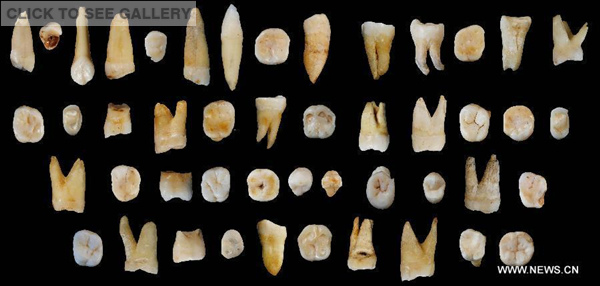Photo provided by the Institute of Vertebrate Paleontology and Paleoanthropology under the Chinese Academy of Sciences shows tooth fossils found in Daoxian county in central China's Hunan Province. (Photo/Xinhua)
"Imagining the life of ancient man based on fossil evidence may seem like a romantic pursuit for some, but scientific research is hard work, and not the least bit romantic," said archeologist Cai Yanjun.
Cai is one of China's leading paleontologists and part of a team that has just made some astounding breakthroughs in the study of the origins of modern humans and their primordial dispersal.
"Science is sometimes dry and frustrating," he said, "but the pursuit of truth, and simple faith that the truth will be found, are what motivate all the best scientists."
Cai's team found fossilized teeth in a cave in central China's Hunan Province that indicate an early form of modern homo sapiens living in the region more than 80,000 years ago. The 47 teeth may in fact date back as much as 120,000 years and could be the oldest remains of a completely modern human from east Asia. The Chinese Academy of Sciences (CAS) team published its findings in this month's edition of the journal "Nature."
The teeth found in Daoxian are significantly smaller than those of humans from the the mid and late Pleistocene, indicating that they belong to an earlier epoch. However, the simple biting surface; the short, thin roots; and shape of the crown are typical of modern humans.
It was back in October 1984 when archaeologists from Hunan and scientists the from CAS institute of vertebrate paleontology and paleoanthropology found 24 mammal fossils in a cave in Daoxian County. Years of research led the scientists to concluded that it was very likely that human fossils would be found in the region. The search for human remains restarted in 2011.
TEETHING TROUBLE
Yang Xiongxin was once a simple laborer. He describes himself as "not a well-educated person" without any previous knowledge of archeology: "But I'm an archaeology enthusiast now for sure!"
Yang used to do simple manual work as a bench worker and warehouseman, and started work at Daoxian cultural relic management center in 2006. He was transferred to the research team in 2011, and, although he is no scientist, he was the one to find the first fossil.
Nothing was found at the start of the project after days of digging. The scientists were talking about changing the search area when Yang spoke up: "We had spent such a long time setting up the equipment in the cave, that I said we could not just give up like that. It might not be so easy to find a similar cave in a short time."



















































